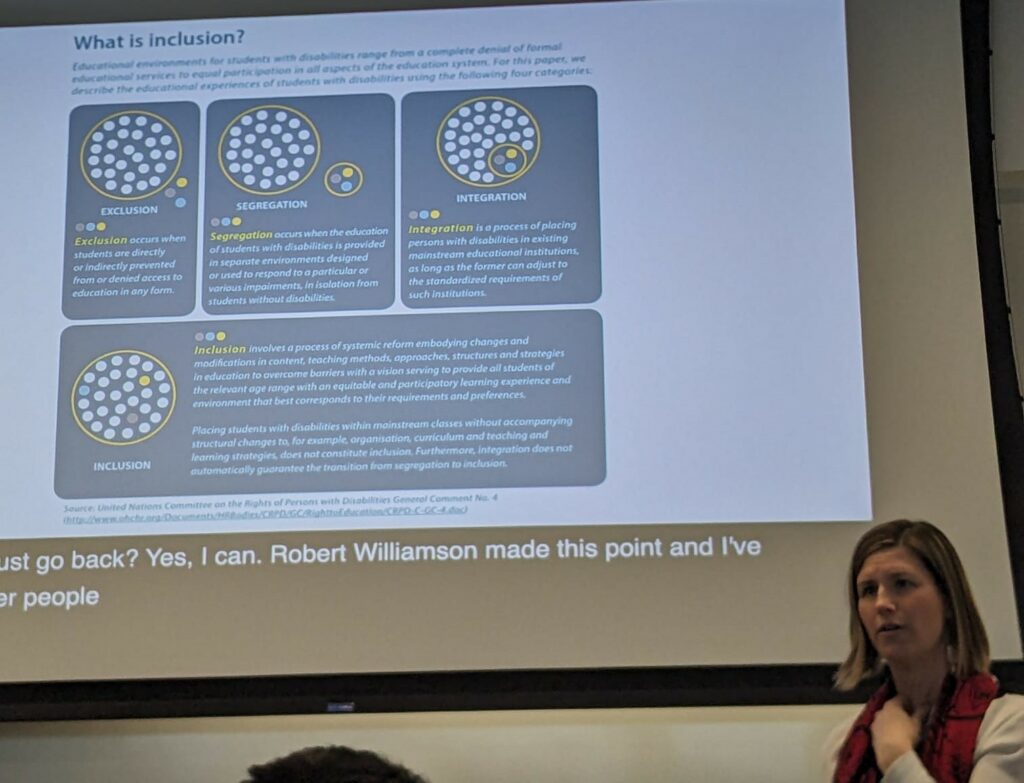




What does inclusion mean to me?
The above quotes were scattered across a few tables for us to read and reflect on and they got me thinking, “If I was to write my own inclusive quote, what would it say?” What do I believe? I don’t have my own inclusion quote yet, but it is part of my growth plan to reflect and come up with something that I can stand by in my own practice.
In the past, I worked with a student who had cerebral palsy, deafblindness, was tube fed, required medications, and full physical support. Lessons were not often set up to include her needs. Teachers actively set up the furniture in their rooms to include her in seating plans, considered her needs for field trips, and made sure to have rewards (prizes) that would be suitable for her. But, her needs were so high and much of her therapy took her out of class, she wasn’t often considered in the academia and activities that the other children were doing.
I tried really hard to create opportunities for her peers and her to interact. We did talent shows, I included students in her light therapy sessions, took them for walks with us, created opportunities for students to listen to stories with her with a shared listening device, and much more. Socially she was included in almost every part of school; in the classroom she experienced integration. I think inclusion means creating an environment where every student feels not only welcomed, but thought of in the creation of the space and learning opportunities.
Gym class was always inviting. This space was set up in such a way where all students needs were met. There were stations for children who wanted to play competitive sport, an obstacle courses, gaga ball, open areas for dancing, hula hoops and skipping ropes area, and a colouring station (for breaks). In this space, all children had voice and choice. They were fully engaged because the area was designed with every child in mind. This was inclusion! This was UDL!
Universal Design for Learning is one way of looking at inclusion. It means to design your lessons in such a way that every child has opportunity and that the adaptations we may make for one are actually beneficial for all. Shelley Moore demonstrates this idea fantastically with her bowling metaphor. We must not aim for the middle, a true strike can be achieved by aiming around the side and back, in a full wrap-around method.
Inclusion also means understanding that all students learn differently fair doesn’t mean equal. It means students have voice and choice and that every students’ needs and story have been carefully considered.
Inclusion means teaching to the entire class that diversities and differences should be accepted and celebrated and that we can also find commonalities between each other. It is not enough that the teacher is inclusive, but they must also teach their students what it is through constant conversation and modelling.
All students belong. We must create spaces where everyone is welcome, everyone is seen, and everyone feels safe and set up for success. It is only then that we can teach.
When Wendy Palmer visited us, she talked about SOGI and the importance of inclusive language and being an ally. What does being an ally mean to me? Language is powerful. I believe my biggest takeaway from this visit was to listen to what I am saying and what I am not saying. How does the way I address the class include all learners? When I say, “boys and girls” am I considering that not all students feel that these terms are accurate? What am I implying when I use language that forces students into a category that they aren’t comfortable with? Do I have materials that only support “traditional” gender roles and family dynamics? Am I making assumptions?
Inclusivity stretches far beyond learning differences. It stretches into culture, religion, gender, race, physical differences, sexual orientation, and beyond. Inclusivity means everyone is welcome and everyone matters.